Oklahoma City construction boom continues amid rising interest and labor costs
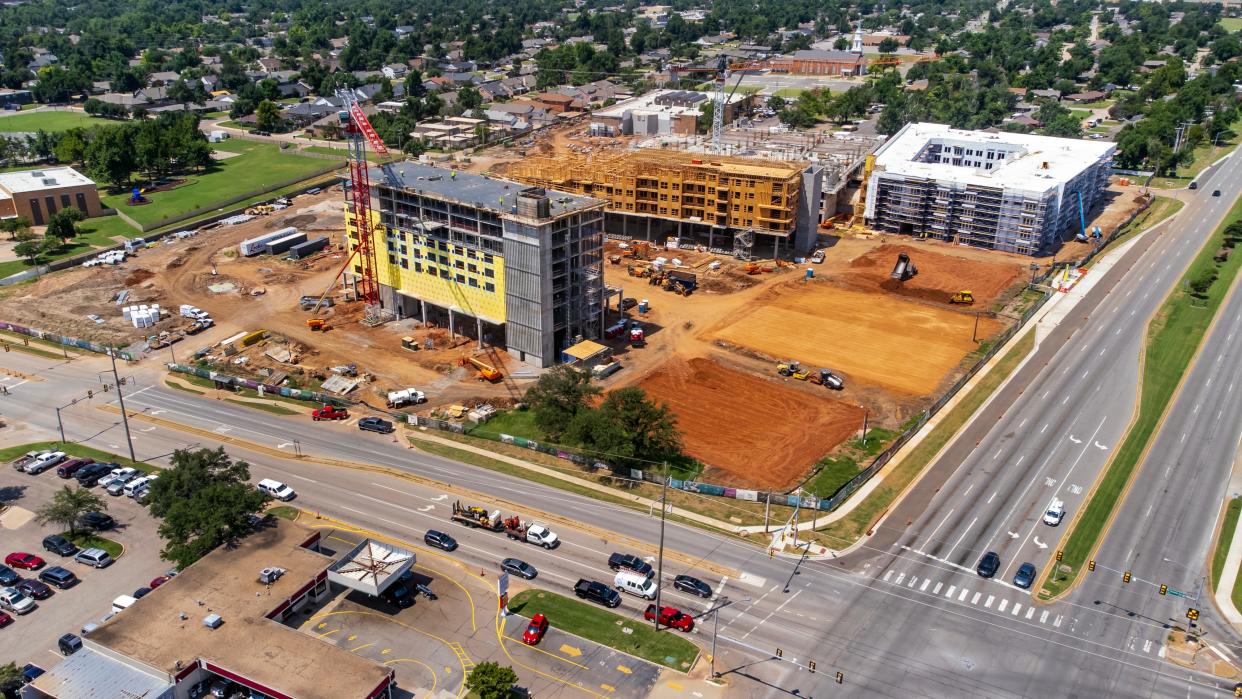
Rising labor and interest costs are stalling developments both locally and nationwide, but the construction cranes hovering over downtown Oklahoma City tell a very different story.
A global construction and management consulting firm published a survey in June showing confidence in the construction industry is falling with high costs starting to impact demand. And the pain is real with local projects already under construction.
Oklahoma City is seeing developers hit with cost spikes putting projects on the cusp of cancellation. Yet the construction spree that began when the COVID-19 pandemic eased is showing no signs of slowing with construction totaling in the billions still planned to start within the next couple of years.
So why has Oklahoma City been able to defy the cost increases and continue its construction boom?
Mark Beffort, a veteran broker and developer, saw costs for Convergence, a mixed-use technology park east of downtown, jump by $25 million. Beffort and partner Dick Tanenbaum trimmed several architectural finishes to cut costs to keep their overall cost at $190 million.
The pair also are developing OKC 577, a $1 billion industrial park along Interstate 240 in southeast Oklahoma City. The Chickasaw Nation saw costs for OKANA, the resort being built along the Oklahoma River, jump by $100 million to a total of $400 million.
Spiraling costs also didn’t stop Pratt & Whitney from starting construction this summer on a $255 million sustainment center or Ryan McNeill from proceeding with spending more than $200 million building The Oak mixed-use development.
The total being spent on just the five mega-projects (developments topping $100 million) in Oklahoma City tops $1.8 billion.
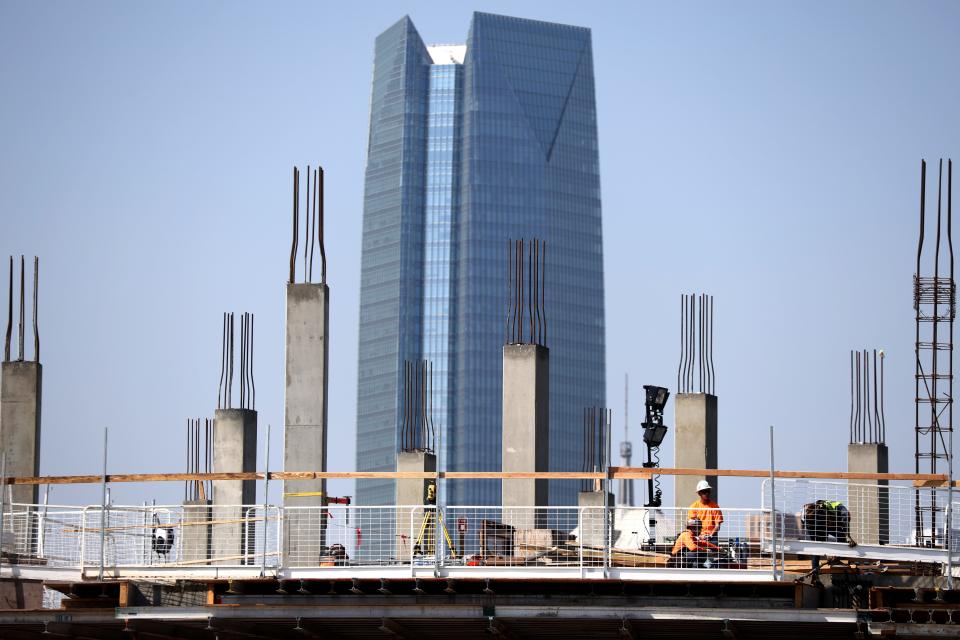
OKC building boom not tied to oil and gas industry
“This is unprecedented for Oklahoma City,” Beffort said. “We've never seen anything this dramatic, even if you price-adjust what was spent during the oil boom in the 1980s. And the good thing is it’s all diverse, it’s not just office space for oil and gas businesses.”
The energy industry that once fueled major developments isn’t even a part of the equation; the current list of mega-projects is a mix of bio-tech, defense, retail, entertainment, hospitality, housing and industry.
The same can be said for an array of developments that are still significant but not among the costliest being built.
Pivot Project is building a $17.5 million office building at NW 11 and Hudson and is set to start work this winter on a $55 million apartment complex at NW 4 and Shartel. Pivot Project also is set to start work with Utah-based Qfactor on a $49 million mixed-use development at SW 3 and Shartel.
A development group led by Richard Labarthe and owners of Core Bank are set to build an $80 million office and apartment development at NW 13 and Broadway. Tanenbaum is set to start renovations of two historic buildings on Broadway into apartments and two large apartment developments stalled for the past few years are about to get started at NW 4 and Broadway and at Oklahoma City Boulevard and E.K. Gaylord.
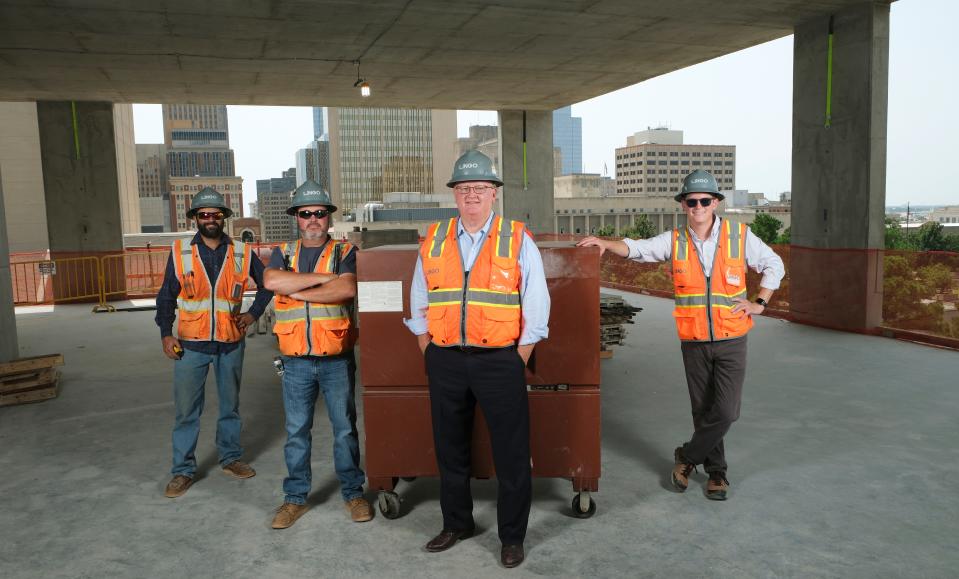
Contractors staying busy
Contractor Stan Lingo is overseeing construction of both the $72 million Citizen tower at NW 5 and Robinson and a five-story Phillips Murrah office building at NW 10 and Walker that is at least $20 million.
Lingo saw business grow 30% this year over last and is looking at another 30% increase in 2024. His firm, which employs 120 full time and 600 more on job sites, has taken a “selective” approach to taking on new projects.
“We’ve had a ton of growth for Lingo Construction,” Lingo said. “Lingo says 'no' to more projects than it says ‘yes’ in terms of pure volume and number. Our goal is to serve existing clients well. We are looking for entrepreneurial owners who do repeat projects. When we see that type of client, we still chase them. It’s the one and done clients we say ‘no’ to.”
Lingo admits, however, that the rising costs for customers has prompted his firm to find creative ways to provide better price points on jobs.
“Projects still have to produce income for owners,” Lingo said. “We have had to tighten belts to reduce project costs to allow the investors to make money.”
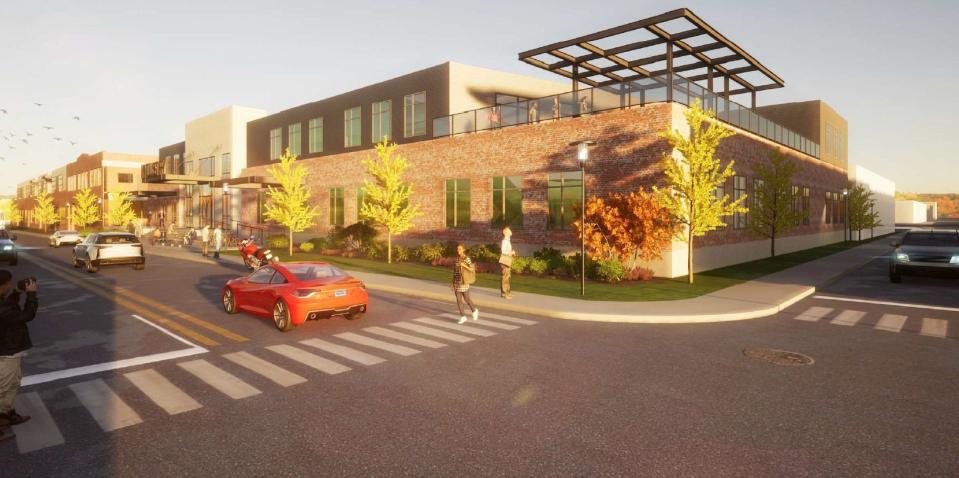
Regional bankers, city assistance keep some projects moving forward
Candice Baitz, a partner in the Pivot Project, credits part of the construction boom to regional banks that haven’t shut off lending. Despite rising costs, the Pivot Project still is looking at starting work soon on a $55 million apartment development at NW 4 and Shartel.
“Regional banks are still willing to work through things if you have a creative development team ready to come up with solutions,” Baitz said.
Oklahoma City’s tax increment financing assistance is credited with preventing several projects from total collapse.
The city has several tax increment financing (TIF) districts, though one of the largest, downtown, is set to expire in 2026. TIF districts subsidize developments by reinvesting resulting property tax increases back into the project cost.
The Oklahoma City Council recently approved a record-high $200 million TIF agreement with California developer Scot Matteson for his proposed Boardwalk at Bricktown.
The $736 million development, which Matteson said will start in June 2024, will consist of a 348-room Hyatt Dream Hotel, two twin 28-story apartment towers and a third tower to be built when the first two are leased.
The development also will include a mix of retail and two parking garages. If the project comes together on the current schedule and budget, the Boardwalk at Bricktown will have started after just a couple of years of planning and negotiations.
Stephen Watts wishes towers could be built so easily. Watts’ firm, Rose Rock Development Partners, launched two Urban Renewal projects in 2018 that, had original plans been followed, would already be open but have yet to get started.
Boulevard Place, an eight-story apartment tower, was announced in 2018 but ran into a series of delays due to site contamination cleanup, pandemic-related slowdowns and inflationary costs that led to a series of changes aimed at keeping the project on track.
By 2021, the developers faced a 20% increase in steel prices, which then were followed by steep jumps in labor and interest costs.
The project, on the verge of being scrapped, was salvaged when a divided city council agreed to cancel the original $5.7 million TIF allocation for Boulevard Place and to create a new, 25-year agreement that would provide up to $21.5 million in development assistance.
“What we saw especially last year, and 2021 through 2022, was you had costs rising so quickly that you would go another two to three months and it’s up 30%,” Watts said. “You couldn’t break ground because you couldn’t get your costs locked down to sign a contract. We’re seeing some construction costs slowing down, but interest rates are continuing to rise.”
Watts said the interest rate spikes prompted his team to end plans to use HUD financing to save money on Davis Bacon wage requirements that required union labor, with higher pay rates, on jobs using federal funding. Watts hopes to start construction on Boulevard Place later this year.
Rose Rock’s second project, Alley’s End, apartments and retail planned at NW 4 and Broadway, was delayed due to waiting on affordable state tax credits and other incentives that are now secured. Watts said construction will begin in early 2024.
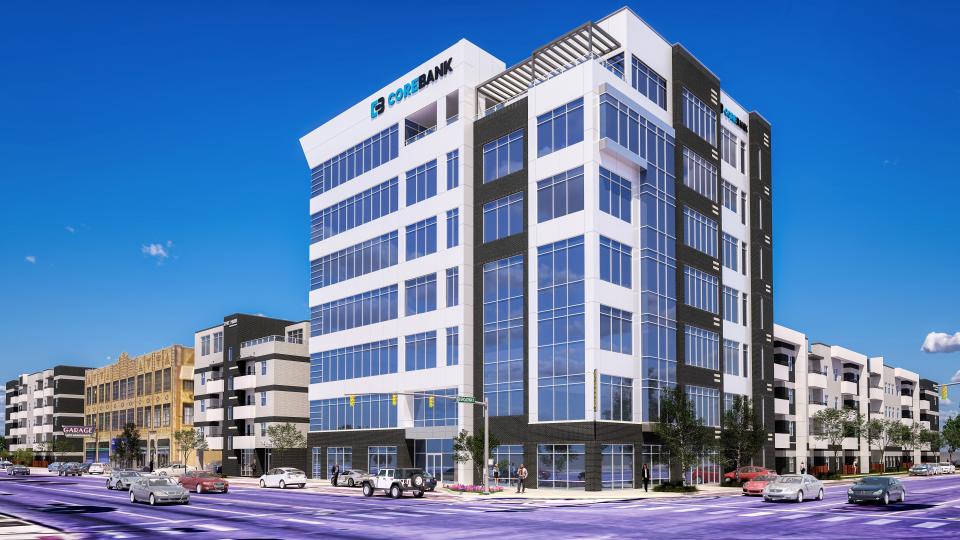
The Hub at NW 13 and Broadway also lingered for years and developers recently noted they were about to shelve the project before they were provided TIF assistance on a rebate basis similar to the arrangement with Matteson for the Boardwalk at Bricktown. If nothing gets built, the tax increment finance payments don’t happen.
Some projects are stalled and are not, so far, able to obtain tax increment financing from the city. Brandon Lodge saw costs go up by 30% for his planned Nova project at 1 NE 6. He said he’s still planning to proceed with construction of the project, which as originally announced was to include a full-size grocery, an urban greenhouse, a brewery, 20 apartments and shops.
“It’s in flux,” Lodge said. “It's definitely tough times right now, but that leads to creative solutions. We’ve had to relook at some of project to keep it in line with rising costs.”
Clay Farha also is trying to restart work on Classen Marquette at 1111 Classen Drive, across from the Plaza Court Building in Midtown.
Plans called for a four-story building abutting Classen Drive with restaurants and retail on the first floor topped with three floors of apartments. Farha said his project also was hit hard by interest costs and that construction will start at the earliest in 2024, at the latest in 2025.
“What cash flows at 4% doesn’t cash flow at 8%,” Farha said. “And what’s really hurting are the interest rates and construction costs.”
McNeill and Beffort point out they started their projects prior to the worst of the construction and interest rate cost increases. They don’t know if things might have turned out differently had they not started before 2023.
“There are real risks when it comes to doing a development like this because it can stretch out over six months,” McNeill said. “The industry building in face of this environment, it’s entirely possible that we’re wrong.”
McNeill did foresee some troubles ahead when he started The Oak and took out a $1 million insurance policy to protect himself from the rate increases. So far, he said, the $1 million is looking like money well spent.
McNeill also takes comfort from bulk transport statistics he sees as a bank board member reviewing loans to trucking companies.
“It's a good forward indicator of where the economy is headed,” McNeill said. “And it’s not telling us there is a recession looming unless there is an unexpected black swan event in the next couple of months. That is creating lingering optimism.”
The rising costs, however, never sit well those taking the biggest risks with larger developments.
“The final chapters of our decision to make this investment is not written until we sell,” McNeill said. “I'm fortunate to have a partner (Everett Dodson) who can weather the market.”
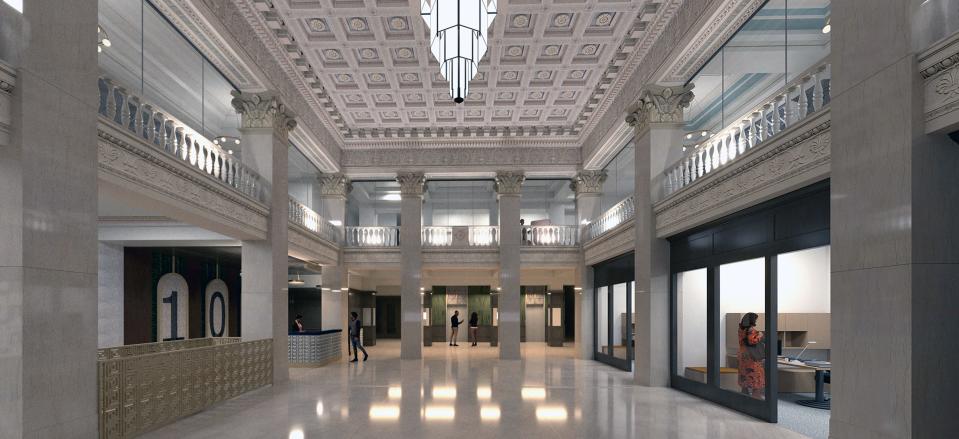
No drop foreseen in demand for construction labor
When Tanenbaum starts construction next month on the $69 million Harlow, the renovation of the former BancFirst and Duncan Oil headquarters buildings will be done by Tanenbaum’s GNG Construction.
Other developers without their own construction companies are expected to face a labor market where labor demand far outstrips supply.
“Material costs have come back down,” Lingo said. “But labor costs will not decrease. The wages paid by companies with warehouses like Hobby Lobby have raised the wage level in the field.”
More: Vital signs: Oklahoma's health care industry growing, providing thousands of jobs
Upcoming public construction will further tap labor supply, Lingo said, noting city voters likely will decide in December whether to spend up to $1 billion or more to build a new arena. More than $200 million will be spent on a new jail.
“In the public sector, we have federal, state and local projects, MAPS, school bonds, and every hospital is in a mode to spend money,” Lingo said. “It’s a competition for labor and materials.”
Even highway construction adds to the strain, and Lingo expects to see competition not just for labor but also for concrete with reconstruction of the Interstate 240/Interstate 35 junction and proposed new turnpikes south of Oklahoma City.
Lingo said his company is employing subcontractors from Kansas City, Wichita, Arkansas and north Texas. He warns local contractors can no longer count on being able to draw subcontractors from Texas.
“Dallas is no cheaper than Oklahoma to build right now,” Lingo said. “There is no incentive for someone from the Dallas market to move to Oklahoma to make money.”
This article originally appeared on Oklahoman: OKC construction is booming despite interest rates, labor costs

